Text
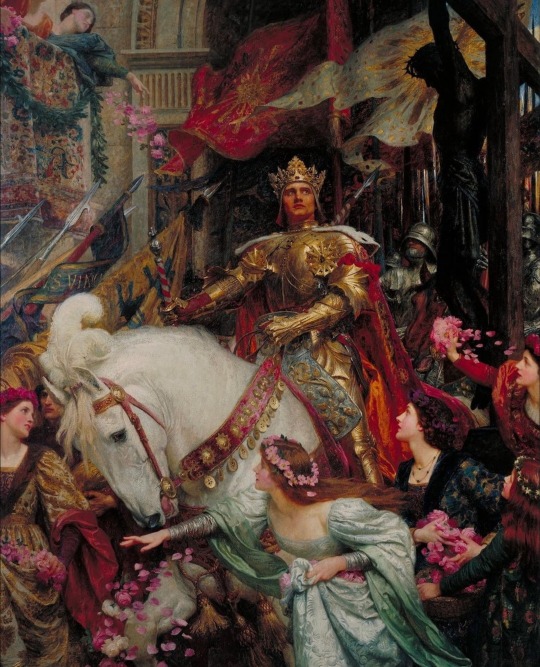
"The Two Crowns" Frank Dicksee (1853-1928) portrays an English medieval prince returning home in triumph on a white horse decorated with three feathers. The Two Crowns of the title are the golden crown of a king and the crown of thorns worn by Christ on the cross. Dicksee invented this highly moral scene in which a medieval king, riding in a triumphal procession, is startled by the sight of a crucifix (or perhaps sees a vision of Christ) and is reminded of the transience of earthly power and success.
In fact the chivalric, Christian knight had been a role model for the modern gentleman for most of the nineteenth century. This painting was bought for the nation from the Royal Academy in 1900 for £2,000.
Sir Frank Dicksee, The Two Crowns (not on display), 1900, Tate Britain, Tate Britain, London
1 note
·
View note
Text
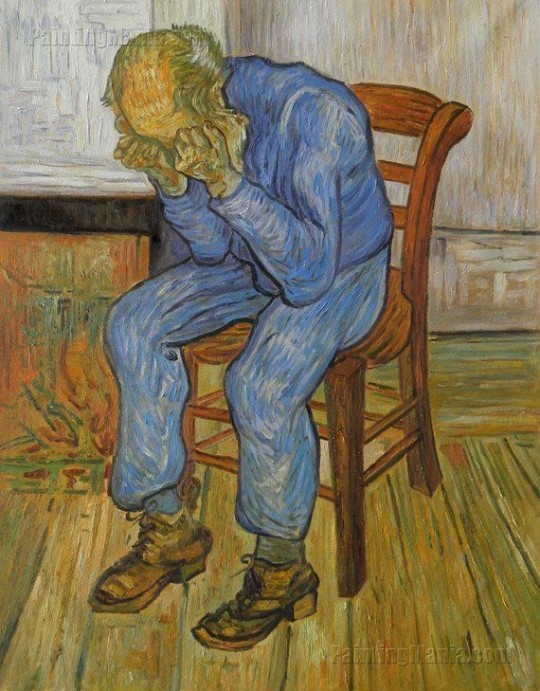
Old man's sorrow (aka At Eternity's Gate)
is an oil painting by Vincent van Gogh that he made in 1890 in Saint-Rémy de Provence based on an early lithograph. The painting was completed in early May at a time when he was convalescing from a severe relapse in his health and some two months before his death, generally accepted as a suicide.
The lithograph was based on a pencil drawing Worn Out, one of a series of studies he made in 1882 of a pensioner and war veteran, Adrianus Jacobus Zuyderland, at a local almshouse in The Hague and itself a reworking of a drawing and watercolor he had made the previous year. The inspiration for Worn Out was Hubert von Herkomer's Sunday at the Chelsea Hospital, an immensely popular print depicting an old war veteran slumped dead that went on to become an acclaimed painting at the Royal Academy, The Last Muster, that van Gogh had seen in 1875 when in England. Van Gogh wrote of his drawing:
"Today and yesterday I drew two figures of an old man with his elbows on his knees and his head in his hands. I did it of Schuitemaker once and always kept the drawing, because I wanted to do it better another time. Perhaps I'll also do a lithograph of it. What a fine sight an old working man makes, in his patched bombazine suit with his bald head."
15 notes
·
View notes
Text
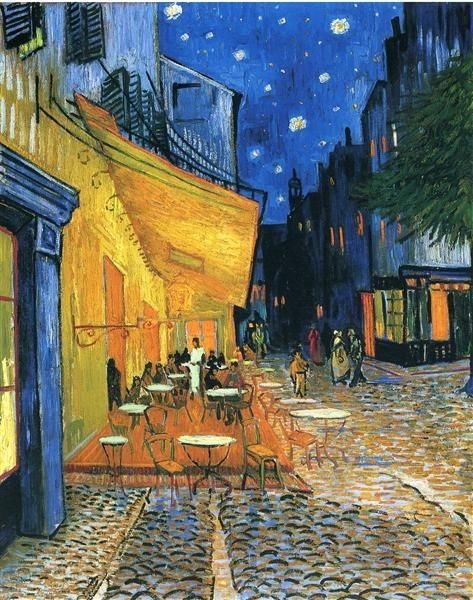
Café Terrace at Night (1888)
In Cafe Terrace at Night the brightly lit cafe radiates with warmth and inviting light, becoming a beacon of yellow set against the rich, dark blue of a night sky, which in turn is illuminated with myriad bright stars. It is an image full of symbolism for the artist, whose works had gradually become more significant in this respect. The underlying symbolism in this and other paintings of a similar nature that he made, however, is one that was understood primarily by the artist, but was not necessarily so obvious to the impartial viewer. This in turn was a further reflection of the personal, almost therapeutic role that Van Gogh's painting had come to represent to him, and was one that would become increasingly so. The artist attached the colour yellow to feelings of religious inspiration, light and happiness and wrote regarding his Yellow House, 'I have had my little house pointed yellow, because I want it to be a house of light for everyone.' applied this feeling to the brightly lit yellow cafe that had been a welcoming haven of sorts for the artist.
25 notes
·
View notes
Text

Bedroom in Arles (1888)
This was Van Gogh’s bedroom in ‘The Yellow House’, which he shared with Gauguin. The closed door on the left led to the spare bedroom, in which Gauguin slept. In a letter to his friend, Vincent stated that the original painting in this series came about due to an extended bout of illness during which he was bedridden for several days.
One small and nice fact that keen-eyed observers might note is the miniature portraits hanging next to the bed. This is the 19th-century equivalent of putting polaroids of your friends on the wall – the people pictured are Van Gogh’s contemporaries and good friends Eugène Boch and Paul-Eugène Milliet.
This painting might well be three times as famous as other ones on this list – because ‘Bedroom in Arles’ is actually the title given to three nearly identical works, all displayed in different museums around the world.
Each painting offers an intimate depiction of Van Gogh’s bedroom, providing a unique glimpse into how the artist lived. This is where he returned to after a hard day of work, and where he dreamed at night. The paintings are all relatively simple and humble, with a strong focus on an effective use of colour.
15 notes
·
View notes
Text

This famous painting, Self-Portrait with Bandaged Ear by Vincent van Gogh, expresses his artistic power and personal struggles. While living with his friend (this is up for debate) and fellow artist Paul Gauguin in Paris, Van Gogh proved to be a less-than-perfect roommate. He and Gauguin had frequent disagreements, which occasionally turned violent. Van Gogh painted it in January 1889, a week after leaving hospital. He had received treatment there after cutting off most of his left ear (shown here as the bandaged right ear because he painted himself in a mirror). Van Gogh returned from hospital to find Gauguin gone and with him, the dream of setting up a ‘studio of the south’, where like-minded artists could share ideas and work side by side.
5 notes
·
View notes
Text

Irises (1889)
After checking himself into an asylum due to his deteriorating mental health, Van Gogh almost immediately began to work on this painting. He referred to the act of painting as “the lightning conductor for my illness”, and threw himself into his work by creating depictions of the Saint Paul-de-Mausole asylum’s flower garden.
It’s not hard to imagine that spending all day in the garden gave Vincent some sort of serenity or peace, however temporary it may have been. While the artist himself considered it to be simply a ‘study’ (not good enough to be a work of art in its own right), his brother Theo realised that Vincent had created something special and submitted it to the Société des Artistes Indépendants, where it was exhibited alongside Starry Night Over the Rhône.
Van Gogh’s Irises are perhaps the best example of the artist creating work of extreme aesthetic appeal. The painting is full of light, life and natural beauty – with a hint of Japanese inspiration, as found in Almond Blossoms. Simply put, it’s spectacular to look at, and bursting with colour.
217 notes
·
View notes
Text
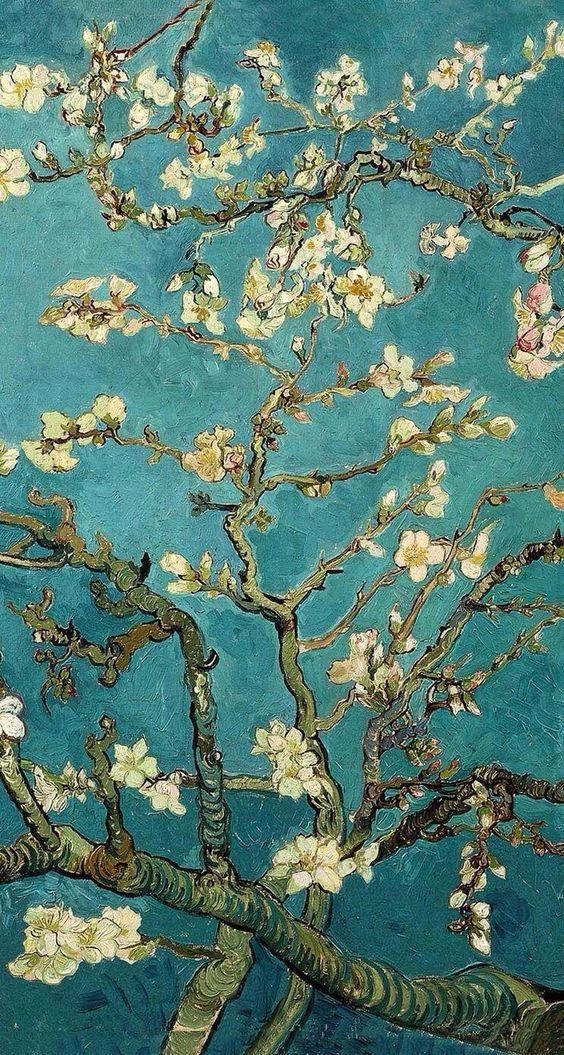
Almond Blossoms (1888–1890)
Van Gogh enjoyed the most productive era of his career during his time in Southern France, referring to Arles as “the Japan of the South” due to its abundance of sunlight and flowering trees. He first arrived in March 1888, as the fruit trees began to blossom, and immediately began painting at an almost unprecedented rate:
“I am up to my ears in work for the trees are in blossom and I want to paint a Provençal orchard of astonishing gaiety.”
This particular work, Van Gogh’s most famous painting of almond blossoms, was created for another special reason: the birth of his nephew, the son of his brother Theo. It’s one of the rare Van Gogh paintings in which you can see hope, joy, and serenity – which makes it all the more special.
13 notes
·
View notes
Text

Wheatfield with Crows (1890)
In his final days, Van Gogh painted several depictions of the wheatfields surrounding him. Out of them, this one is the most famous, but also the darkest. It seems to show a sense of isolation and loneliness, with a path ending in the middle of the field, going nowhere, circled by crows. It’s a gloomy image.
Completed in July 1890, this may well have been Van Gogh’s final work – there are unfortunately no conclusive letters or records on the matter. The fact remains that this painting was completed the same month that Vincent shot himself in the chest, either near or in the depicted field of wheat. It’s impossible to look at this painting without this grim realisation in mind.
2 notes
·
View notes
Text

The Potato Eaters (1885)
It doesn’t have the colourful star power found in some of his later work, but The Potato Eaters is still considered one of the most famous Van Gogh paintings. Created in 1885, slightly before the other paintings featured so far, this painting reveals the artist’s Dutch roots.
Van Gogh loved this painting. Two years after finishing it, he wrote a letter to his sister claiming that ‘’… the painting of the peasants eating potatoes that I did in Nuenen is after all the best thing I did“. It’s likely that the subject matter and the execution of the painting was quite close to Van Gogh’s heart, and that he was genuinely excited at having finished what he considered to be one of his masterpieces
7 notes
·
View notes
Text

Self-portrait (1888)
Van Gogh often painted pictures of himself. There are various reasons that might come to mind (pure artistic vanity, or wanting to document his physical and mental changes), but there’s another one that isn’t often brought up: he simply didn’t have the money to pay for models to sit down for hours at a time. While Van Gogh didn’t live in abject poverty – a myth that is often repeated – managing money was a struggle.
His correspondence with his brother reveals a reliance on his monthly allowance from Theo, which never seemed to be quite enough to match Vincent’s ambitions. Art supplies were expensive back then, as they are now, and hiring a model may have been one step too far for someone who was inspired primarily by nature.
More than anything, the story behind this painting follows Van Gogh’s own journey, particularly as it relates to his mental health. While in a letter to his brother (discussing this self-portrait) he insists that he’s in a better place now, in retrospect it’s painfully obvious to see that all was not well.
“I hope you will notice that my facial expressions have become much calmer, although my eyes have the same insecure look as before, or so it appears to me.”
5 notes
·
View notes
Text
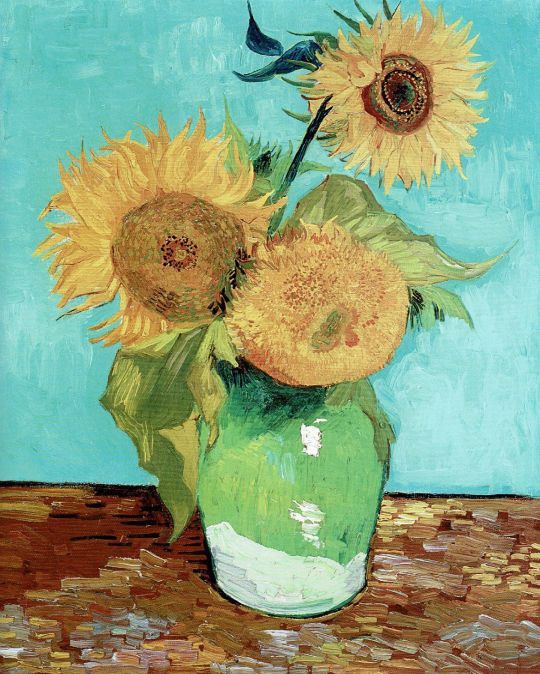

Sunflowers is not just one painting, but in fact two entire series of multiple paintings of sunflowers. Most of the time, when someone refers to Van Gogh’s ‘Sunflowers’, they’re talking about the series he created while in Arles, consisting of four initial versions and three repetitions on the same idea.
Lesser known are the ‘Paris Sunflowers’, which he created while living with his brother in Paris between 1886 and 1888. Less triumphant and not in full bloom, these sunflowers are nonetheless pretty spectacular to see, and can be found at museums including The Met in New York, the Kröller-Müller Museum, and (of course) the Van Gogh Museum in Amsterdam.
11 notes
·
View notes
Text

Starry Night Over the Rhône, is one of Vincent van Gogh's paintings of Arles at night. It was painted on the bank of the Rhône that was only a one or two-minute walk from the Yellow House on the Place Lamartine, which Van Gogh was renting at the time. The night sky and the effects of light at night provided the subject for some of van Gogh's more famous paintings, including Café Terrace at Night (painted earlier the same month) and the June, 1889, canvas from Saint-Remy, The Starry Night.
10 notes
·
View notes
Text

The Starry Night is an oil-on-canvas painting by the Dutch Post-Impressionist painter Vincent van Gogh. Painted in June 1889, it depicts the view from the east-facing window of his asylum room at Saint-Rémy-de-Provence, just before sunrise, with the addition of an imaginary village. Starry Night is one of the most recognized pieces of art in the world. It is absolutely everywhere, too. It can be seen on coffee, mugs, t-shirts, towels, magnets, etc. Honestly, it sometimes feels as if the painting’s fame has exceeded that of its creator. It is a magnificent piece of art. That Starry Night resonates with so many people is a testament to how its beauty is timeless and universal.
6 notes
·
View notes
Text

Vincent Willem van Gogh 30 March 1853 – 29 July 1890) was a Dutch Post-Impressionist painter who posthumously became one of the most famous and influential figures in Western art history. In a decade, he created about 2,100 artworks, including around 860 oil paintings, most of which date from the last two years of his life. They include landscapes, still lifes, portraits, and self-portraits, and are characterised by bold colours and dramatic, impulsive and expressive brushwork that contributed to the foundations of modern art. Not commercially successful, he struggled with severe depression and poverty, eventually leading to his suicide at age thirty-seven.
3 notes
·
View notes